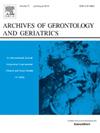抗糖尿病药物诱发肌肉疏松症的全球负担:一项国际药物警戒研究。
IF 3.8
3区 医学
Q2 GERIATRICS & GERONTOLOGY
引用次数: 0
摘要
背景:肌肉疏松症是一种对老年人群构成重大风险的病症,而糖尿病被认为是一种风险因素。最近有证据表明,常用于抗糖尿病治疗的 GLP-1 RA 有可能诱发肌肉疏松症。本研究旨在调查肌肉疏松症与各种抗糖尿病药物(包括 GLP-1 RAs)之间的关联:本研究分析了世界卫生组织国际药物警戒数据库中 1967 年至 2023 年期间的报告(报告总数,n = 131,255,418 份)。我们分析了报告的几率比(ROR)和信息成分(IC),以评估肌肉疏松症与七类抗糖尿病药物之间的关联:这些药物包括:DPP-4 抑制剂、GLP-1 RAs、胰岛素、二甲双胍、SGLT2 抑制剂、磺脲类药物和噻唑烷二酮类药物:有关抗糖尿病药物导致肌肉疏松症的报告逐渐增多(n = 508;258 名男性 [50.79%])。总体而言,抗糖尿病药物与肌肉疏松症有显著关联(ROR,1.31 [95 % CI,1.20-1.44];IC,0.38 [IC025,0.24])。在各类药物中,SGLT2 抑制剂显示出最高的关联性(ROR,2.49 [95 % CI,1.93-3.22];IC,1.30 [IC025,0.87]),其次是二甲双胍(ROR,1.86 [95 % CI,1.43-2.41];IC,0.88 [IC025,0.44])、DPP-4 抑制剂(ROR,1.67 [95 % CI,1.17-2.38];IC,0.72 [IC025,0.12])和胰岛素(ROR,1.27 [95 % CI,1.11-1.45];IC,0.34 [IC025,0.11])。尽管 GLP-1 RAs 的报告数量较多,但并未观察到与肌肉疏松症有显著关联(n = 93;ROR,1.06 [95 % CI,0.86-1.29];IC,0.08 [IC025,-0.27]):结论:抗糖尿病药物与肌肉疏松症有显著关联,其中 SGLT2 抑制剂的关联性最强。值得注意的是,尽管有大量报道,但 GLP-1 RAs 并未显示出显著的关联性。本文章由计算机程序翻译,如有差异,请以英文原文为准。
Worldwide burden of antidiabetic drug-induced sarcopenia: An international pharmacovigilance study
Background
Sarcopenia is a condition that poses a significant risk in the older population, with diabetes identified as a risk factor. Recent evidence suggests that GLP-1 RA, commonly used as antidiabetic treatments, may potentially induce sarcopenia. This study aimed to investigate the association between sarcopenia and various antidiabetic drugs, including GLP-1 RAs.
Methods
This study analyzed reports from the World Health Organization international pharmacovigilance database, covering the period from 1967 to 2023 (total reports, n = 131,255,418). We analyzed the reported odds ratio (ROR) and information component (IC) to evaluate the association between sarcopenia and seven classes of antidiabetic drugs: DPP-4 inhibitors, GLP-1 RAs, insulin, metformin, SGLT2 inhibitors, sulfonylureas, and thiazolidinediones.
Results
Reports of antidiabetic drugs-associated sarcopenia have gradually increased (n = 508; 258 males [50.79 %]). Overall, antidiabetic drugs showed significant associations with sarcopenia (ROR, 1.31 [95 % CI, 1.20–1.44]; IC, 0.38 [IC025, 0.24]). Among the individual drug classes, SGLT2 inhibitors showed the highest association (ROR, 2.49 [95 % CI, 1.93–3.22]; IC, 1.30 [IC025, 0.87]), followed by metformin (ROR, 1.86 [95 % CI, 1.43–2.41]; IC, 0.88 [IC025, 0.44]), DPP-4 inhibitors (ROR, 1.67 [95 % CI, 1.17–2.38]; IC, 0.72 [IC025, 0.12]), and insulin (ROR, 1.27 [95 % CI, 1.11–1.45]; IC, 0.34 [IC025, 0.11]). Despite the high number of reports for GLP-1 RAs, no significant association with sarcopenia was observed (n = 93; ROR, 1.06 [95 % CI, 0.86–1.29]; IC, 0.08 [IC025, -0.27]).
Conclusions
Antidiabetic drugs showed significant associations with sarcopenia, with SGLT2 inhibitors exhibiting the strongest association. Notably, despite numerous reports, GLP-1 RAs did not show a significant association.
求助全文
通过发布文献求助,成功后即可免费获取论文全文。
去求助
来源期刊
CiteScore
7.30
自引率
5.00%
发文量
198
审稿时长
16 days
期刊介绍:
Archives of Gerontology and Geriatrics provides a medium for the publication of papers from the fields of experimental gerontology and clinical and social geriatrics. The principal aim of the journal is to facilitate the exchange of information between specialists in these three fields of gerontological research. Experimental papers dealing with the basic mechanisms of aging at molecular, cellular, tissue or organ levels will be published.
Clinical papers will be accepted if they provide sufficiently new information or are of fundamental importance for the knowledge of human aging. Purely descriptive clinical papers will be accepted only if the results permit further interpretation. Papers dealing with anti-aging pharmacological preparations in humans are welcome. Papers on the social aspects of geriatrics will be accepted if they are of general interest regarding the epidemiology of aging and the efficiency and working methods of the social organizations for the health care of the elderly.

 求助内容:
求助内容: 应助结果提醒方式:
应助结果提醒方式:


